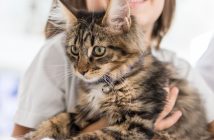Mark Kittleson has gone a long way from his childhood, raising dairy cattle, to raising cats at the University of California-Davis. His scientific research as a veterinary cardiologist, however, may help future generations of cats live longer, healthier lives.
Kittleson co-authored a study, along with researchers from The Ohio State University and Baylor College of Medicine, that identified a gene mutation that was responsible for hypertrophic cardiomyopathy, a disease that causes thickening of the lower left chamber of the heart. This disease was the serious cause of death in young athletes such as former Loyola Marymount University basketball player, Hank Gathers, and Boston Celtic star, Reggie Lewis. He got into the research of hypertrophic cardiomyopathy after a call from Marcia Munro, a client in Connecticut with a special interest in the feline version of the disease. Her Maine Coon cat “Golden Girl” had the illness.
Upon researching the illness, the cat?s owner discovered that hypertrophy cardiomyopathy as her cat had been diagnosed, was a genetic disease in human beings. However, when she contacted the breeder and asked if any of her cat’s relatives had the disease, she wasn’t surprised the answer was a resounding, “No.” Dissatisfied with this answer, she began to research cat shows and elsewhere to find Golden Girl’s relatives. She found that some of them had the disease as well. After more intensive study, it was finally determined that the disease was inherited within cats, the same was as it was in humans.
In the human version of the disease, there is usually no sign of the disease during the first decade of life. Kittleson’s research found similar results in felines. “In cats there are no signs in the first year,” he said. “They had the same natural history as humans so we assumed it was most likely due to the same sorts of mutations found in humans.”
“The goal is to identify cats who have these genes and then to get them out of the breeding pool, so they do not pass it on to their offspring.
Primarily the research is for cats, but it can potentially help with genetic engineering and gene therapy in both humans and cats.



